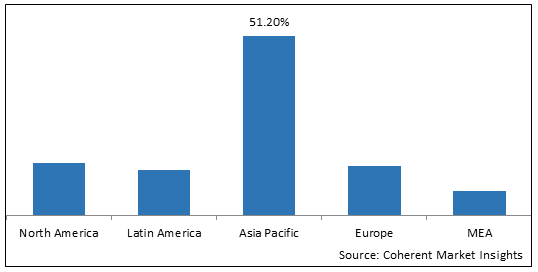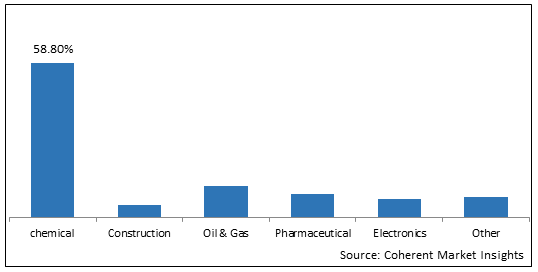Bromine Derivatives Market is estimated to be valued at USD 5,666.7 Mn in 2025 and is expected to reach USD 8,503.8 Mn in 2032, exhibiting a compound annual growth rate (CAGR) of 5.97% from 2025 to 2032. Bromine is a chemical compound with atomic number 35 and a third-lightest halogen compound. It is a fuming red-brown liquid at room temperature and its properties are almost similar to chlorine and iodine. It is a fuming red-brown liquid at room temperature and its properties are almost similar to chlorine and iodine. Bromine derivatives are widely used in the controlling mercury emission and halogenated flame retardants. Moreover, bromine derivatives are also used in the manufacturing of rechargeable batteries. Some of the end-use application of bromine derivatives are pharmaceuticals, agriculture, and electronics, along with growing construction.
Drivers
Growing demand for bromine derivative from automotive and consumer electronics industries is expected to fuel the market growth of bromine derivatives. Bromine derivatives are used in the production of flame retardant electronic products in the automotive industry. Moreover, the rising application of bromine derivative from the oil and gas industry in the drilling of fluid for extracting petroleum product is further expected to fuel the market growth of bromine derivatives over the forecast period. Additionally, growing number of manufacturing industries, especially in India and China, are further projected to propel the market growth.
Growing construction is used in the Roofing, insulation, wall coverings, windows, piping, decks, and fences, is projected to fuel market growth. Moreover, rising demand for plastic and rubber products is also projected to fuel the market growth of bromine derivative. Furthermore, the increasing application of bromine derivative in the textile industry coupled with the significant increase the urbanization is further projected to augment the market growth of the bromine derivative.
Figure 1. Global Bromine Derivatives Market Value Share (%), By Region, 2025

To learn more about this report, Download Free Sample
Market Restraints
Rising usage of non-halogenated flame retardants as bromine flame retardant is banned across most of the regions such as Europe and North America, due to their neurodevelopmental toxicity, thyroid effects, and other side-effects on human health. Therefore, rising concerns over halogenated flame retardants are projected to hamper the market growth of bromine derivative over the forecast period. For instance, in February 2019, The EU banned exports of four brominated flame retardants and three other substances, under amendments made to legislation controlling the trade of very hazardous chemicals. This is expected to hinder the market growth of bromine derivative.
Moreover, increasing usage of magnesium hydroxide in brominated flame retardants as it exhibits the same properties and benefits as brominated flame retardants are further expected to inhibit the market growth over the forecast period. Also, in some regions phosphorus-based flame retardant such as red phosphorus is widely used non-halogenated flame retardants due to mechanical and electrical properties similar to halogenated flame retardants. This is expected to hinder the market growth over the forecast period.
Bromine Derivatives Market Report Coverage
| Report Coverage | Details | ||
|---|---|---|---|
| Base Year: | 2024 | Market Size in 2025: | USD 5,666.7 Mn |
| Historical Data for: | 2020 To 2024 | Forecast Period: | 2025 To 2032 |
| Forecast Period 2025 to 2032 CAGR: | 5.97% | 2032 Value Projection: | USD 8,503.8 Mn |
| Geographies covered: |
|
||
| Segments covered: |
|
||
| Companies covered: |
Israel Chemicals Limited, Albemarle Corporation, Tosoh Corporation, Tata Chemicals Limited, Chemtura Corporation, Jordan Bromine Company, Gulf Resources Inc., Hindustan Salts Limited, and Tetra Technologies Inc. |
||
| Growth Drivers: |
|
||
| Restraints & Challenges: |
|
||
Uncover macros and micros vetted on 75+ parameters: Get instant access to report
Market Trends
Rising usage of bromine-based oxidizing biocides for cooling towers, swimming pools, sanitary disinfection, and treatment of municipal sewage is expected to augment the market growth over the forecast period. Rising investment by developed countries such as North America is also projected to fuel market growth. For instance, in July 2019, Lanxess announced multiple project expansion plans across the region by 2022, which also includes an investment of USD 60 million in the global bromine reservoir site.
Rising usage of bromine derivative in the surface treatment of rubber used for tires along with the growing usage on the formulation for cleaning surface of printed circuits is projected of fuel the market growth of bromine derivative. Also, increasing usage of bromine derivatives such as methyl bromide in the development of fertilizers and pesticides is expected to foster the market growth of bromine derivatives. Therefore, the booming agriculture industry around the globe is projected to augment the market growth of bromine derivatives over the forecast period.
Increasing Usage from the Water Treatment Segment
With the rising need for sustainability, and industries focusing on complete water treatment solutions to increase the recyclability of water, bromine derivatives are expected to grow significantly during the forecast period.
According to UN Data, in 2020, around 56 percent of household wastewater flows were safely treated globally.
Bromine derivatives are used in the preparation of biocides for water treatment. Bromine-based biocides work efficiently at controlling the microbiological load in water systems while ensuring corrosion is kept under check. Stabilized bromine-based biocides are widely used in industrial applications such as cooling towers and pre-treatment processes since they eliminate the need to control pH for efficacy.
One such bromine derivative, dimethyl hydantoin (DBDMH) is being widely used as a disinfectant in recreational water treatment, with limited use in drinking water purification. It is also used as a bleaching agent in the pulp and paper industry. DBDMH is also widely used in treating industrial and commercial water-cooling systems.
The overall growth of the water treatment industry is expected to be a strong driver for the overall demand and consumption of bromine derivatives used in the water treatment application.
Figure 2. Global Bromine Derivatives Market value Share (%), By Product Type, 2025

To learn more about this report, Download Free Sample
Recent Developments
Competitive Section
Major players operating in the global bromine derivatives market include Israel Chemicals Limited, Albemarle Corporation, Tosoh Corporation, Tata Chemicals Limited, Chemtura Corporation, Jordan Bromine Company, Gulf Resources Inc., Hindustan Salts Limited, and Tetra Technologies Inc.
Share
Share
About Author
Yash Doshi is a Senior Management Consultant. He has 12+ years of experience in conducting research and handling consulting projects across verticals in APAC, EMEA, and the Americas.
He brings strong acumen in helping chemical companies navigate complex challenges and identify growth opportunities. He has deep expertise across the chemicals value chain, including commodity, specialty and fine chemicals, plastics and polymers, and petrochemicals. Yash is a sought-after speaker at industry conferences and contributes to various publications on topics related commodity, specialty and fine chemicals, plastics and polymers, and petrochemicals.
Missing comfort of reading report in your local language? Find your preferred language :
Transform your Strategy with Exclusive Trending Reports :
Frequently Asked Questions
Select a License Type
Joining thousands of companies around the world committed to making the Excellent Business Solutions.
View All Our Clients